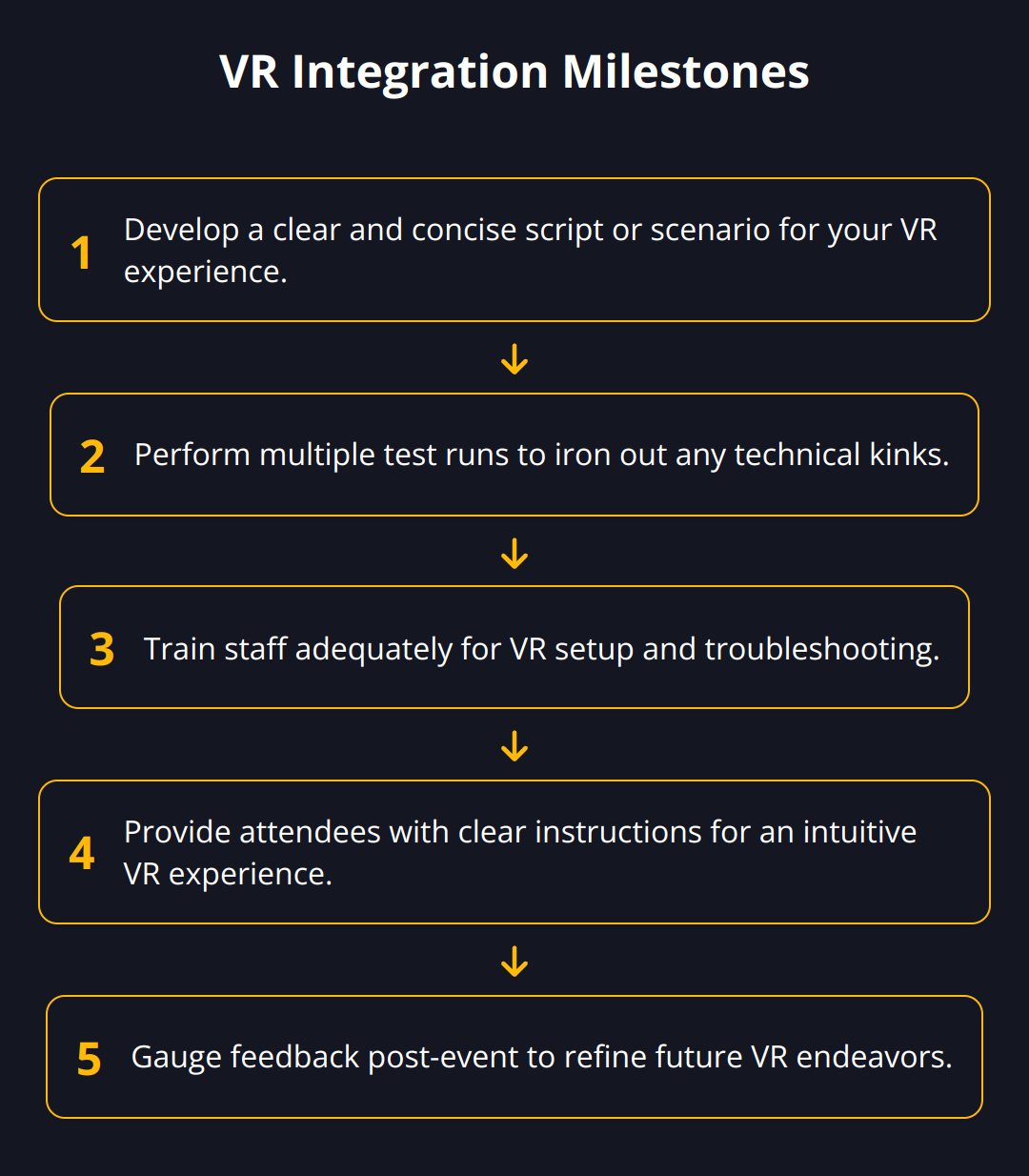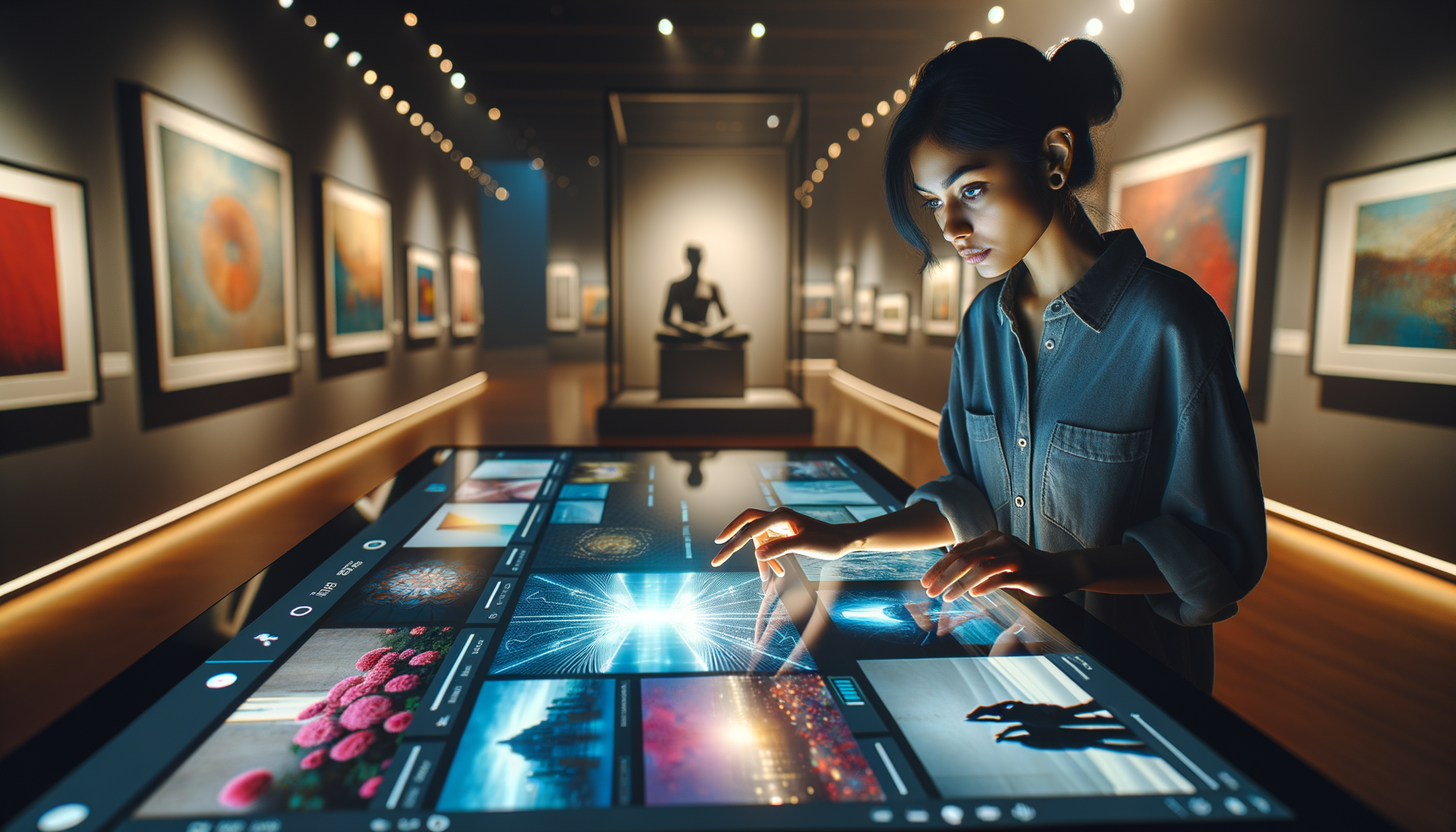We at newroom connect recognize the dynamic shift that Virtual Reality (VR) technology is bringing to events. From immersive experiences that captivate attendees to innovative marketing strategies that propel brand narratives, VR is transforming the event landscape.
This post will guide beginners through the essentials of VR, the compelling advantages it offers for events, and practical steps to integrate VR technology successfully. We aim to shed light on the potential of VR to elevate event experiences and offer actionable insights for those looking to venture into this exciting space.
VR Tech Explained
Virtual Reality technology offers a portal into a fully immersive digital realm, manipulating our senses to experience a computer-generated world as if it were real. This high-tech wizardry hinges on a simple, yet sophisticated setup: a VR headset is your window into a 3D environment, tricking your brain into seeing depth and dimension, while tracking technologies allow you to interact with this virtual space as you move your head and body.
Here are the fundamental elements that comprise VR technology:
-
Head-Mounted Display (HMD): The VR headset is what immerses you visually into the virtual world. Advanced models come with built-in motion sensors and cameras to detect your movements accurately.
-
Input Devices: Tools like hand controllers, gloves, and treadmills can be employed to interact with the virtual environment, making the virtual feel tangibly real.
-
Processing Unit: A powerful computer or a gaming console is the engine room, driving the VR experience by rendering the virtual environment and reacting to user movements in real-time.

When contemplating VR experiences for events, we are met with a spectrum of possibilities, each with its unique appeal:
-
Fully Immersive VR: Offers the deepest level of immersion where every sensory input comes from the virtual environment, perfect for transformative event experiences or enthralling product demos.
-
Semi-Immersive VR: Provides a partial virtual experience, often incorporating physical components, useful for educational and training purposes at seminars and workshops.
-
Web-Based VR: Accessible via a web browser, it can serve as a teaser for larger events or as a platform for virtual exhibitions when user accessibility is imperative—a prime example being virtual art gallery showcases.

Selecting the right type of VR experience is pivotal to your event’s success. A hands-on product launch might warrant fully immersive VR, while a museum tour could be adequately served with a web-based VR walkthrough. Insightful statistics from prominent studies bolster our position. For instance, according to a report by Grand View Research, the global VR in education market size is expected to reach $13.1 billion by 2026, which signifies the growing adoption and immense potential of semi-immersive VR in learning environments.
Similarly, the retail landscape is going through a silent revolution with virtual showrooms. Retailers incorporating VR are not only witnessing a surge in customer engagement but also an impressive uptick in sales, as this guide to virtual showroom designs details. The immersive aspect of VR allows potential clients to connect with products on a deeper level, even before the first physical touchpoint.
Tapping into VR technology for your event isn’t as daunting as it seems. With the right tools and a streamlined approach, you can craft experiences that are not only cutting-edge but also memorable and effective in achieving your event objectives. Keep your eyes peeled for the next chapter, where we will walk through the steps of planning and implementing VR at your next event.
How Does VR Amplify Event Impact?
Virtual Reality technology is not just about providing flashy gadgets for attendees to play with; it’s a transformative tool that has reshaped the event industry. When VR is integrated into an event, it’s not merely an addition – it’s a game-changer that can dramatically amplify the experience, marketing reach, and overall execution.
Transforming Attendee Engagement
One of the most compelling uses of VR is its ability to immerse participants in a virtual world, offering an unparalleled level of engagement. Imagine walking trade show attendees through a virtual product demonstration where they can interact with your product in a hyper-realistic setting. It’s like giving them a test drive of the future right there on the show floor.
An event equipped with VR technology can provide experiences that regular video or static displays simply cannot match. Attendees are more likely to remember what they’ve actively engaged with rather than what they’ve passively watched. The statistics are clear: engagement rates for VR are through the roof, with users showing a 27% higher emotional engagement compared to a 2D environment, according to a study by YuMe and Nielsen.

Opening New Marketing Avenues
VR is not just an attendee magnet; it also serves as a powerful branding tool. When attendees don their VR headsets, they’re transported into a brand narrative you control. Each visual, sound, and interaction point is an opportunity to fortify your brand image and deliver your message in a memorable way.
Innovative use of VR for branding could be seen at events like virtual car launches where prospective customers experienced the thrill of driving a new model without leaving the showroom floor. The marketing potential here is immense, with VR ads shown to generate a 70% higher recall than non-VR ads, as demonstrated by research from Greenlight VR and Horizon Media.
Streamlining Event Execution
Behind the scenes, VR can play a pivotal role in planning and executing events. A virtual walkthrough of the event space, for example, can help planners visualize the layout and troubleshoot issues before the actual setup. It saves time, effort, and resources, which are often in short supply when it comes to event planning.
Moreover, VR can simulate crowd flows, emergency routes, and lighting setups, providing organizers with a bird’s-eye view of the event dynamics. This preemptive planning can lead to a smoother, safer event and a more productive use of the space.
<>
Here are a few actionable insights:
-
Use VR to conduct virtual site inspections, reducing travel costs and time.
-
Integrate VR in your marketing plan to create buzz around your event.
-
Collect data on user interactions within the VR environment for post-event analytics.
Harnessing VR in the event space is not science fiction; it’s a reality that’s here to enhance the way events are created, marketed, and experienced. With careful implementation, the return on investment can be substantial, paving the way for more innovative, engaging, and effective events. The next steps involve planning and setting up of these VR systems, a journey well worth undertaking for the forward-thinking event planner.
Integrating VR: Where to Start?
Taking the plunge into Virtual Reality for your events can be a monumental step in crafting a cutting-edge, memorable experience. The starting point involves having a razor-sharp focus on VR objectives, choosing the appropriate technology, and designing an immersive journey for your attendees.

Pinpointing Your VR Goals
Before diving into the vast ocean of VR possibilities, pinpoint exactly what you want to achieve. Whether it’s to dazzle with a virtual product launch, educate through a VR training session, or create a buzz with an interactive exhibition, define your goals upfront. Precise objectives guide your strategy and prevent you from veering off into tech gimmickry that fails to add true value to your event.
Selecting VR Gear Wisely
Next, navigate the VR hardware and software landscape with a discerning eye. High-end headsets like the Oculus Rift S or Valve Index might offer the ultimate immersive experience, but can your budget stretch to cover them? Perhaps a more cost-effective yet still effective alternative, like the Samsung Gear VR, fits the bill. Match your hardware choices to your goals—don’t splurge on top-tier equipment for a simple VR showcase. And on the software front, whether you’re developing a custom VR application or using off-the-shelf solutions, ensure compatibility and a user-friendly experience.
Crafting the VR Journey
Having the correct setup is one thing, but the magic lies in crafting the VR journey. Here’s where you map out every interaction point from start to finish. Remember, a memorable VR experience is more than stunning visuals; it needs a narrative arc that aligns with your brand message. Develop a storyboard that transitions smoothly through different scenarios, engages through interactivity, and culminates in a meaningful conclusion.
Practical Integration Steps

By adhering to these steps, VR can go from being a novel attraction to an integral, impactful part of your event. It requires meticulous planning, judicious tech choices, and a creative roadmap but embark on this journey with confidence, and you’ll deliver an unforgettable immersion into your brand’s world. Stand by for our next chapter where we delve into seamless execution strategies for VR in events.
Final Thoughts
The advent of Virtual Reality has brought about a renaissance in the event industry, providing a canvas for creativity and a new medium for storytelling. The potential of VR to transform events is immense, offering experiences that resonate more deeply with audiences and create lasting impressions. This transformative effect is seen across various sectors, from education to retail, and the stats speak volumes about its growing impact.
![Key Takeaways - Event Virtual Reality Tech [Beginner's Guide]](https://newroom-connect.com/wp-content/uploads/2024/02/Event-Virtual-Reality-Tech-Beginners-Guide-6-2024-02-20-070812.7091320000.png)
For event organizers who are just beginning to explore the possibilities of VR, it is important to approach the technology with a clear set of goals and an understanding of the options available to you. VR can be a considerable investment, but its deployment at your events can result in substantial returns in terms of attendee engagement, brand loyalty, and overall event success.
The future of events hinges on technology that can deliver unique, memorable interactions—and VR stands at the forefront of this evolution. With the power to transport users to other worlds, VR prepares us for a future where events are not bound by physical constraints, where the limits of engagement are only defined by our imagination.
As we explore the untapped vistas of VR, we encourage beginners to make their start and experienced planners to push the boundaries even further. Remember, VR is not just a passing trend, it’s a powerful tool that, when used well, can redefine the landscape of events.
We at newroom connect are advocates for innovation. Our software platform is built to ease your transition into the virtual event space and enhance the engagement of your audiences with stunning realism. Be it exhibitions or e-learning environments, we ensure your events are immersive, interactive, and unforgettable. Our commitment to you is unwavering support, expert guidance, and a seamless setup process.
-
Boost Engagement: Create captivating experiences that guests will remember.
-
Build Brand Loyalty: Tell your brand’s story in a comprehensive virtual world.
-
Limitless Possibilities: From trade shows to virtual museums, there’s no end to what you can create.
-
Accessibility: Reach a global audience any time of the day.
-
Cost Savings: Replicate and customize events without the hefty price tag.
We believe your next event can be revolutionary with the expert use of VR, and we’re here to help make that happen. To start your journey in creating immersive virtual landscapes, visit newroom connect. Let’s shape the future of events together and unlock the boundless opportunities that Virtual Reality offers.


